An Herb Garden for Tea Time
People around the world have been creating tea gardens for as long as they have been drinking tea. In China and Japan, the tradition dates back not just centuries but millennia. Eastern cultures have long appreciated the psychological and spiritual importance of creating contemplative places for sipping tea. In Europe, tea gardens are also a venerable tradition. For hundreds of years the English, famous tea drinkers, have cultivated herbs in formal and cottage gardens and appreciated their harvest in that most celebrated of cultural rituals, afternoon tea. In our frenetically paced modern lives, making time for growing herbs and savoring herbal infusions may seem like an anachronism, a quaint throwback to a more unhurried age. But we need such time-tested tonics, places to slow down and enjoy nature's bounty, seemingly more than ever. The garden at the bottom of the page is tailored to modern gardeners and tea lovers who lead busy lives. Below is advice on how to enjoy the pleasures of harvesting and drying fragrant and flavorful herbs for tea.
Harvesting and Drying Herbs
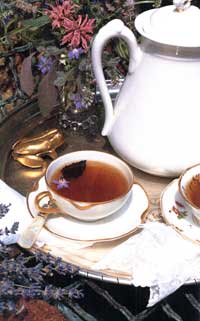
Most herbs should be harvested just before they bloom. Choose a sunny day and harvest in the morning, when the herbs' oils are strongest. Never pick herbs when they are wet; wait until the morning dew has evaporated. Don't leave cut herbs out in the sun; take them into a shady area to sort and tie into bunches.
In cold-winter areas the last harvest should be six to eight weeks before the first hard freeze to give perennials time to harden off new growth. At your final harvest, cut annuals to the ground and cut back perennials to about two thirds of their height.
To dry herbs, tie the stalks into small bundles with string or twine and hang them up. You can also spread the herbs on screens or in baskets. Leave small or needlelike leaves like those of thyme and rosemary on their stems, but remove large leaves from stalks. Place the bundles, screens, or baskets in a dry, well-ventilated place out of the sun, such as a shed or attic. Depending on the climate and humidity, drying can take from a few days to two weeks. Check the herbs every day; if you leave them too long, especially in humid weather, they will turn brown.
Alternatively, you can use your refrigerator to dry herbs. Simply place small bundles of freshly harvested herbs in paper bags, label them, and place the partially closed bags on a shelf. The fridge-drying process is slow—about two weeks, depending upon the thickness of the leaves—but worth the wait. In the cool environment and relative darkness of the refrigerator, herb leaves retain valuable essential oils and more chlorophyll. You can completely dry the herbs in the fridge and then use them from the bag as needed. Or, remove all excess moisture and store them in a cool, dark place.
A fully dried herb will crackle and crumble when rubbed between your fingers. If the leaves are not crisp, they still contain some moisture. To remove the last bit of excess moisture and completely dry the herbs, finish them in the oven. Preheat the oven to its lowest temperature, but definitely under 200°F, and then turn it off. Spread the herbs on baking sheets and place them in the warm oven for about five minutes. Repeat if necessary.
Once the herbs are completely dried, strip whole leaves from the stems and pack them in clean, dark-glass jars with tight-fitting lids. (Incompletely dried herbs will get moldy and spoil.) Don't crumble the leaves as you pack them or you'll release their essential oils.
Herbs for a Tea Garden
Aloysia citriodora, Lemon Verbena
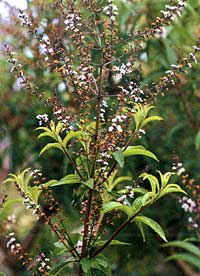
Lemon verbena has the most assertive fragrance and flavor of all the lemony herbs. Its strong, sweet citrus aroma and lemon-rind flavor make it a wonderful choice for tea. The plant has woody stems with narrow, pointed, bright green leaves. In southern regions or in a greenhouse it may grace you with white flowers tinged with lavender.
Growing Tips Lemon verbena requires full sun and a porous, loamy soil. Grow it in a protected spot even in warm climates and cultivate it in a pot north of Zone 8. Propagate from new-growth cuttings taken in late spring, or start from root cuttings in moistened sterilized soilless mix. Fertilize it with fish emulsion, prune judiciously during the growing season, and prune well in early fall. Remove about a third of the total plant, pruning smaller branches back to older growth. Lemon verbena drops its leaves when cold weather arrives. Mulch it for winter protection if its stays outdoors, or move it into a cool greenhouse. Water it lightly in winter. Hardy in Zones 8 to 10.
Cultivars and Related Species None.
Companion Plants Group lemon verbena with basil (Ocimum basilicum cultivars), the spiky flowers of pineapple sage (Salvia elegans), and the furry foliage of fruit-scented and ornamental sages (Salvia species and cultivars). The woody stems and pale green leaves combine well with the variegated foliage of Alaska nasturtiums (Tropaeolum majus cultivars).
Matricaria recutita, German Chamomile
Chamaemelum nobile, Roman Chamomile
The plants of both genera have ferny green foliage with small daisylike flowers. In tea, the flowers have a mild, sweet, fruity taste, but those of Roman chamomile (syn. Anthemis nobilis) have slightly more bitter components. Walking on a mat of Roman chamomile, a perennial groundcover, is an aromatic experience. Drinking tea made from the plant may cause allergic reactions in those sensitive to ragweed (Ambrosia artemisiifolia).
Growing Tips Ground-hugging Roman chamomile spreads slowly over time, sending up bloom stalks that can reach 10 or 12 inches. Propagate it by seed, layering, or cuttings. Sow German chamomile in spring or fall. The upright plants grow about 10 to 12 inches tall and can flower two to three times a year. Both species like well-drained, loamy, moist soil and full sun; Roman chamomile can tolerate some shade. Gather the blooms when they first open and use them fresh, or preserve them by freezing or drying. Hardy in Zones 4 to 9.
Cultivars and Related Species Chamaemelum nobile 'Treneague' is a fragrant groundcover that does not bloom; C. nobile 'Flore Pleno' has showy white ruffly double blooms.
Companion Plants Set chamomile between stones or bricks along the edge of a walkway with other low growers, or allow its foliage to tangle with that of love-in-a-mist (Nigella) or brightly colored nasturtiums (Tropaeolum).
Melissa officinalis, Lemon Balm
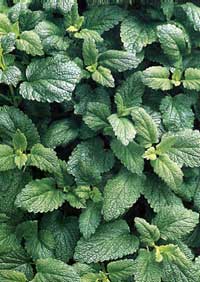
The fragrances of lemon and honey mingle in lemon balm's leaves. Patches of the 2- to 2 1/2-foot-tall plant attract large numbers of bees, especially when it's in bloom. Lemon balm contributes a subtly sweet, grassy flavor and a hint of lemon to a variety of dishes. Steep the crushed fresh leaves with iced tea or lemonade to make a delicious hot-weather beverage; in winter, the dried leaves make a nice hot tea, though some of the herb's aroma is lost in drying.
Growing Tips Lemon balm thrives in full sun but will grow in partial shade. Start it from seed, root cuttings, or by root division. It prefers light soil but will grow in heavy clay if it is amended with compost. Give each plant two feet all around. Trim during the growing season to keep it bushy. Hardy in Zones 4 to 9.
Cultivars and Related Species Melissa officinalis 'Aurea' and 'All Gold', two variegated cultivars, add color with their yellow-and-green leaves. Cut 'Aurea' back in the summer since its colors fade. 'All Gold' will burn in full summer sun.
Companion Plants Since lemon balm spreads easily and will compete for space, plant it next to other vigorous perennials such as mints (Mentha cultivars) or alliums, such as Allium senescens subsp. montanum, or A. cernuum).
Mentha aquatica, Orange Mint
Also called bergamot, water mint, and eau de cologne mint, orange mint is highly perfumed with a strong citrus flavor, but unlike other mints, it has very little menthol. This lovely plant has ovate leaves tinged purple on the underside and lavender-pink flowers. It grows to between two and three feet tall. The delightful flavor of orange mint is delicious in iced drinks and exceptional in fruit preserves and desserts. All mints are so good in tea blends that it's worth growing more than one type. Used in cold-water infusions they make wonderfully refreshing beverages.
Growing Tips Cut back plants and gather herbs for drying two to three times during the season; cut plants to the ground at the fall harvest. Hardy in Zones 5 to 9. For more tips, see Mentha x gracilis 'Madalene Hill'.
Cultivars and Related Species Peppermints, the strongest-flavored mints, are high in menthol and make a stimulating tea. Look for Mentha x piperita 'Mitcham's' (syn. 'Blue Balsam', 'Chocolate', and 'Black-Stemmed Peppermint'). Doublemint (M. x gracilis 'Madalene Hill') combines the flavor of peppermint and spearmint and makes a great tea. Spearmints (Mentha spicata) have a milder, sweeter flavor than peppermints; 'Kentucky Colonel' is a favorite.
Companion Plants Due to their aggressive nature, it's best to confine mints to large pots or tubs.
Monarda didyma 'Cambridge Scarlet', Red-Flowered Bee Balm, Bergamot, Oswego Tea
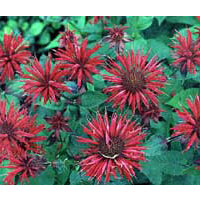
Bees and hummingbirds are drawn to the strong aroma and nectar of red-flowered bee balm's brilliant, shaggy blooms. 'Cambridge Scarlet' grows from two to four feet tall and has a pleasantly strong sweet and flowery taste with citrus undertones. Both flowers and leaves make a delightful beverage and are great with summer fruits and desserts.
Growing Tips Sow seeds in spring or start plants by root division or cuttings. Plant bee balm in sun or partial shade, in loamy soil. Harvest the leaves and flowers throughout the season to use fresh or to dry. Some bee balms are susceptible to powdery mildew, which usually occurs later in the growing season, so harvest a few times early in the season to ensure a harvest to dry. Hardy in Zones 4 to 9.
Cultivars and Related Species Other varieties such as Monarda didyma 'Croftway Pink', 'Mahogany', 'Marshall's Delight', and wild bergamot (M. fistulosa) do not have the same fragrance or taste as the red varieties. They are gorgeous nectar plants, but they contain carvacrol, which gives them a pungent, savory taste similar to oregano.
Companion Plants Bee balms are in the mint family and tend to spread when grown in rich soils. The bright red flowers of Monarda didyma 'Cambridge Scarlet' are wonderful in a mass on their own or grouped with other tall plants such as oriental lilies and coneflowers (Echinacea).
Ocimum 'Mrs. Burns' Lemon', 'Mrs. Burns' Lemon' Basil
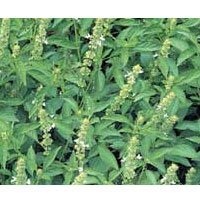
All of the lemon basils have a sweet lemon scent and a first taste of lemon oil with floral tones. Leaves and flowers are delicious in hot or iced tea and lemonade, as well as many other dishes. 'Mrs. Burns' Lemon', a cross between Ocimum basilicum and O. americanum, is a sturdy variety with good lemon fragrance and flavor; 'Sweet Dani' runs a close second. The plants have light, bright green leaves with small white blossoms.
Growing Tips See Greek bush basil (Ocimum basilicum 'Minimum'). Harvest monthly by cutting plants back to just above the bottom two sets of leaves; this will vastly increase your yield.
Cultivars and Related Species Tasting of spice, citrus, and a hint of anise, favorite basils for tea include Ocimum x citriodorum 'Aussie Sweetie' (syn. 'Greek Column' and 'Lesbos') and Thai basils O. basilicum 'Siam Queen', 'True Thai', and 'Thai Purple'.
Companion Plants Combine tall columnar, bright green O. basilicum 'Aussie Sweetie' with the light green leaves of 'Mrs. Burns' Lemon' and the dark green foliage and bright purple flowers of 'True Thai' for a striking grouping.
Rosmarinus officinalis 'Joyce DeBaggio', Golden Rain Rosemary
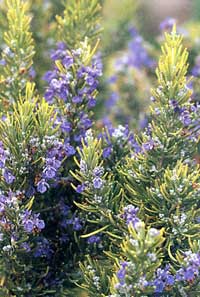
Unique among rosemary varieties, the leaves of the cultivar 'Joyce DeBaggio', named for the wife of herb grower Thomas DeBaggio, are edged in gold. This upright plant with pale blue flowers is tender in northern gardens, but in southern climates it grows like a shrub, reaching up to six feet in height and diameter. It has a resinous and piney aroma and flavor, with hints of citrus. Use the flowers to garnish beverages and desserts. Rosemary tea made from leaves and flowers of any cultivar is restorative, stimulating, and an aid to digestion.
Growing Tips To overwinter container-grown rosemary inside in cool climates, keep it as cool and dormant as possible. Restrict water to avoid fungal diseases, but don't allow the plant to dry out completely. For more growing tips, see Rosmarinus officinalis.
Companion Plants Any rosemary companions such as thymes, oreganos, and savory should be spaced so that they don't touch the foliage.
Salvia elegans · Pineapple Sage
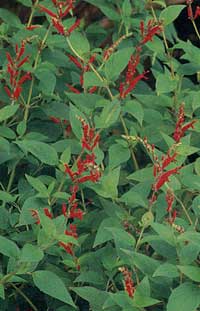
This elegant, sweetly scented tender perennial grows to a large bushy plant that can reach about four feet tall and three feet wide in the South. Pineapple sage's scarlet flower spikes appear very late in summer, and in southern climates, the plant blooms for up to three months. If you move the plant indoors in late fall in northern climates, it may bloom for a few months. When rubbed or brushed, the pointed leaves smell of fruity pineapple. Popular with hummingbirds, the brilliant, long-throated flowers have a sweet, strong floral aroma reminiscent of pineapple. Use them in preserves, desserts, and fruit salads and to brighten iced teas and other beverages.
Growing Tips Pineapple sage grows best in full sun in rich, slightly acidic soil. It is slow to germinate and therefore best propagated by cuttings or root divisions. Unless you live in a warm climate, grow it in a pot and move it to a sunny spot indoors when it gets cold. Hardy in Zones 8 to 11.
Cultivars and Related Species Tender Salvia dorisiana, also known as fruit-scented sage, has big fuzzy heart-shaped leaves and makes a lovely fruity tea.
Companion Plants The bright colors of marigolds (Tagetes species and cultivars), calendulas, nasturtiums (Tropaeolum), coleuses, and miniature chile plants (Capsicum species) are wonderful around pineapple sage.
Salvia officinalis 'Woodcote Farm', 'Woodcote Farm' Sage
A beautiful specimen with two-toned leaves and a faint gray-green variegation, 'Woodcote Farm' sage is welcome in the many-shades-of-green herb garden. Depending on soil and weather conditions, sage may vary in flavor, but camphor is prominent as well as a lemony resinous taste. When sage is dried, the lemon flavor dissipates and camphor and muskiness similar to silage comes forth. Despite its camphorous flavor, tea made from sage can be soothing and pleasant with a drop of honey and a slice of lemon. Or use it as a cold-water infusion.
Growing Tips Plant drought-tolerant hardy sages in well-drained or gravelly soil and full sun or in partial shade with good air circulation. Add calcium if it's lacking in the soil. Once established, sage needs little care; prune in early spring to encourage new growth, and water occasionally. Hardy in Zones 5 to 8.
Cultivars and Related Species Salvia 'Albiflora' has white flowers; 'Berggarten' has large round pungent leaves; 'Nana' has a wonderful growing habit and small leaves. Garden sage (S. officinalis x S. fruticosa 'Newe Ya'ar') tolerates humidity much better than other sages.
Companion Plants Given plenty of space, gray-green sage combines beautifully with any white-blooming flower. It looks good with other purple-blooming herbs such as chives (Allium schoenoprasum), lavender (Lavandula), and anise hyssop (Agastache foeniculum). The variegated pale green leaves of 'Woodcote Farm' sage look good with the white blooms of garlic chives (Allium tuberosum) or a white-flowering rose or bee balm (Monarda). Or try it with the fuzzy silver leaves of lamb's ears (Stachys byzantina).
Stevia rebaudiana, Stevia
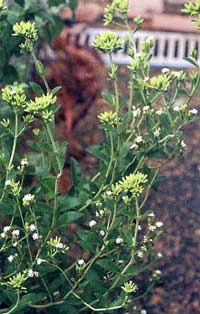
Also known as Paraguayan sweet herb and "yerba dulce," this shrubby tender perennial grows to about 18 inches tall, with tiny white flowers appearing at stem tips in summer. The two-inch, bright green leaves contain stevioside, which can be 100 to 300 times sweeter than sucrose. Paraguayans use it to sweeten bitter drinks like maté and, along with Japanese, Chinese, Korean, and Brazilian cooks, use it for pickles, desserts, and beverages.
Growing Tips Plant stevia in full sun and well-drained soil. This grass- and marshland native prefers some moisture and will not tolerate drought. Propagate by taking stem cuttings before flowers appear. When overwintering stevia, watch the leaves for pests, fertilize monthly, and prune away weak growth. Hardy in Zones 9 to 10.
Cultivars and Related Species There are many species in the genus, but Stevia rebaudiana has the sweetest leaf.
Companion Plants Grow stevia alone in a container or grouped with other sun-loving plants.
Thymus x 'Aureus', Golden Lemon Thyme
French and English thyme may be good for cooking, but lemon thymes are best for tea. They grow in compact little bushes 6 to 12 inches in height and come in a variety of leaf colors from green to gold to variegated. 'Aureus' (or 'Gold Edge'), has green leaves splashed with gold. Its foliage is showy in winter and spring in southern regions, and in early summer it puts forth pink flowers. Lemon thymes have a wonderful citrusy scent and flavor along with a whisper of rose and make a delightful tea. Add the leaves fresh to the teapot for maximum flavor. Dried leaves are less intense but still make a good tea and combine well with other tea herbs.
Growing Tips Mulch plants with sand, light-colored gravel, or chicken grit to keep them dry and discourage disease and mildew. Prune several times a year to prevent disease and keep plants from getting woody, first in early spring, again when flowers begin to form, then in midsummer, and finally about 60 days before first frost. Plants tend to die out from the center. Pruning the tips stimulates new growth from the remaining lower sections, promoting vigorous, bushy specimens. Divide plants in spring or early fall and take root cuttings in summer. Hardy in Zones 5 to 9.
Cultivars and Related Species All cultivars of Thymus x citriodorus have a lovely lemony scent and flavor. 'Silver Queen' has paler, silver leaves, and 'Archer's Gold' has bright yellow leaves. 'Orange Balsam' has an orange fragrance and flavor.
Companion Plants Thymes are best with other low-growing plants that need good drainage. Use them with cheddar pinks (Dianthus gratianopolitanus), germander (Teucrium chamaedrys), lavenders, and savory (Satureja species). Thyme also looks nice growing around rocks and along border edges.
An Herb Garden for Tea Time
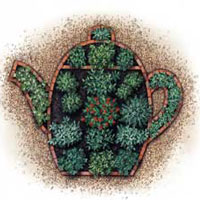
A tea garden can be designed in any number of shapes and configurations, from informal and cottage garden–style to formal and symmetrical to zenlike. You can also get as imaginative and whimsical as you wish, as in the garden plan here. This tea garden has been designed in the shape of a homey teapot; however, one or two teacups, complete with saucers, could also be fun. The teapot measures 8 to 10 feet from lid to bottom, and 10 to 12 feet from handle to spout. This is roomy enough to accommodate 15 to 20 plants, generously spaced. In your own yard, adequate space and sunlight will be the only limitations; just remember that the larger the herb garden, the more maintenance it will require. Time, space, and your tastebuds will dictate how many plants of a given variety you need to grow to have plenty of leaves and flowers on hand to brew your favorite cup.
Design Tips
- Tea gardens should be places for relaxation and reflection. The sense of calm can be accentuated by creating a feeling of enclosure in the garden. This can be accomplished with traditional hedges, trellises or wooden fences, or even rows of good-sized plant specimens in pots.
- Make room in your garden for a tea table and chairs or benches where you can sip your freshly brewed herbal tonic.
- Tea paraphernalia used as garden ornament can add an entertaining touch. For example, try edging a bed with some old teaspoons or mismatched saucers turned on end. Or attach old teacups to garden stakes and use them as plant markers.
- As in any garden in which plants are intended to be eaten, be sure to grow your tea garden organically.
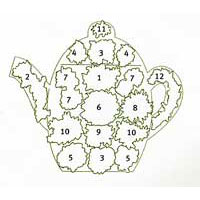
Plants Featured in This Garden
- Aloysia citriodora, lemon verbena
- Matricaria recutita, German chamomile
- Melissa officinalis, lemon balm
- Mentha aquatica, orange mint
- Mentha spicata, spearmint
- Monarda didyma 'Cambridge Scarlet', red-flowered bee balm
- Ocimum 'Mrs. Burns' Lemon', 'Mrs. Burns' Lemon' basil
- Rosmarinus species, rosemarys
- Salvia elegans, pineapple sage
- Salvia species, sages
- Stevia rebaudiana, stevia
- Thymus x citriodorus 'Aureus', golden lemon thyme


